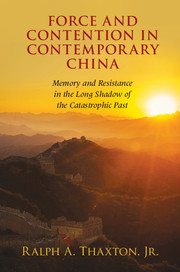 Force and Contention in Contemporary China
Force and Contention in Contemporary China Book contents
- Frontmatter
- Dedication
- Contents
- List of Illustrations
- Acknowledgments
- Cast of Characters for Da Fo Village and Several Other Villages in the Hebei-Shandong-Henan Border Area, 1945–2013
- Maps
- Introduction
- 1 The Violent Dawn of Reform
- 2 Contemporary Tax Resistance and the Memory of the Great Leap
- 3 Birth Planning and Popular Resistance
- 4 Rural Schools and the “Best Citizens of the State”: The Struggle for Knowledge and Empowerment in the Aftermath of the Great Leap
- 5 Official Corruption and Popular Contention in the Reform Era
- 6 The Rise of the Electricity Tigers: Monopoly, Corruption, and Memory
- 7 The Defeat of the Democratic Experiment and Its Consequences
- 8 Contentious Petitioners and the Revival of Mao-Era Repression
- 9 Migration and Contention in the Construction Sector
- 10 The Rise of the Martial Artists and the Two Faces of Mafia
- Conclusion: Big Questions and Small Answers from Da Fo
- Bibliography
- Index
- Miscellaneous Endmatter
6 - The Rise of the Electricity Tigers: Monopoly, Corruption, and Memory
Published online by Cambridge University Press: 05 August 2016
- Frontmatter
- Dedication
- Contents
- List of Illustrations
- Acknowledgments
- Cast of Characters for Da Fo Village and Several Other Villages in the Hebei-Shandong-Henan Border Area, 1945–2013
- Maps
- Introduction
- 1 The Violent Dawn of Reform
- 2 Contemporary Tax Resistance and the Memory of the Great Leap
- 3 Birth Planning and Popular Resistance
- 4 Rural Schools and the “Best Citizens of the State”: The Struggle for Knowledge and Empowerment in the Aftermath of the Great Leap
- 5 Official Corruption and Popular Contention in the Reform Era
- 6 The Rise of the Electricity Tigers: Monopoly, Corruption, and Memory
- 7 The Defeat of the Democratic Experiment and Its Consequences
- 8 Contentious Petitioners and the Revival of Mao-Era Repression
- 9 Migration and Contention in the Construction Sector
- 10 The Rise of the Martial Artists and the Two Faces of Mafia
- Conclusion: Big Questions and Small Answers from Da Fo
- Bibliography
- Index
- Miscellaneous Endmatter
Summary
In his 2002 warning on pandemic corruption, Chairman Hu Jintao focused mainly on local governments and local officials, as if only they, and not Central government politicians, were giving villagers cause to resist the party-state. The thrust of the Deng and post-Deng reform, however, was to restore CCP control at the central and local levels, and this entailed supporting local strongmen such as Da Fo party secretary Bao Zhilong. In this respect, reform actually involved a political restoration of party-centered power as opposed to the charismatic-based power of the Mao period, and Beijing relied on recycled Mao-era officials and local party leaders in hinterland villages where the legitimacy crisis stemming from the Great Leap's damage persisted. This process favored political hustlers who had been in leadership positions previously, and they often became the ground-level agents of Beijing politicians in charge of important sectors of the reform-era political economy.
Sure enough, Da Fo's farmers say that reform-era corruption was structured in part by big-name Chinese Communist Party (CCP) officials in charge of centralized state monopolies. They point out that the extension of state monopoly into the hands of party boss Bao Zhilong's local political network engendered a pattern of audacious rent-seeking at both the macro and micro levels, and their stories reveal that this pattern stoked memories of Great Leap–era domination and abuse. Indeed, in some important ways, corruption in the village was a direct result of the monopoly power of the CCP.
Popular experience with the Central government control of electricity stemmed all the way back to the 1950s when the Mao-led CCP – following Lenin, who took electricity as an icon of modernity – promised to provide rural China with electricity to promote development and alleviate poverty. While the Great Leap saw the construction of miniature hydroelectric power stations in parts of the rural interior, the center did not invest in these stations. The Maoist emphasis, instead, was on commune-supervised electricity-driven water conservancy projects and irrigation wells. The primary beneficiaries were official networks and a few farmers in communes and model villages such as Dingcun in Liangmen People's Commune.
- Type
- Chapter
- Information
- Force and Contention in Contemporary ChinaMemory and Resistance in the Long Shadow of the Catastrophic Past, pp. 207 - 237Publisher: Cambridge University PressPrint publication year: 2016
